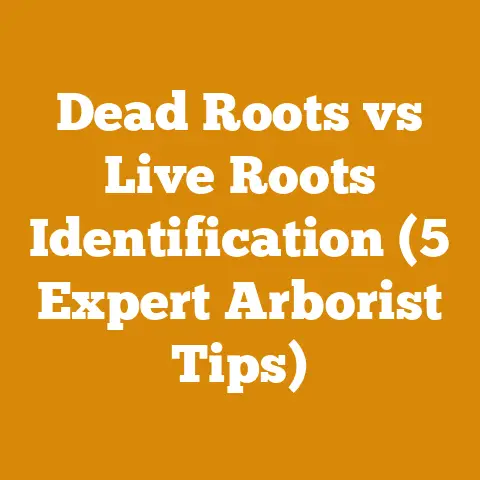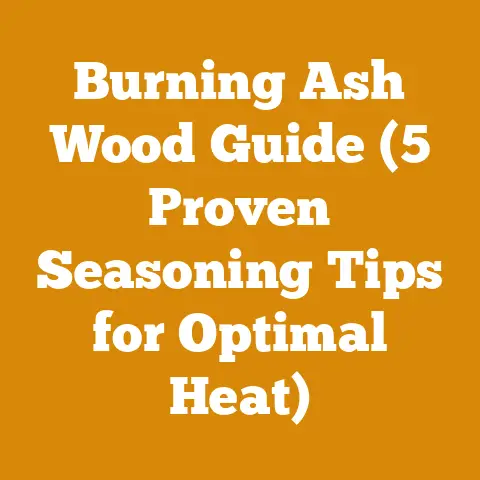Normal Creosote Buildup Explained (Wood Processing Insights)
Okay, let’s dive into the fascinating, and sometimes frustrating, world of creosote buildup in wood stoves and chimneys. I’ve spent years wrestling with this sticky substance, and I’m eager to share my experiences and insights to help you understand and manage it effectively.
Introduction: The Ghostly Residue of Warmth – Understanding Creosote
Picture this: a cold winter night, the wind howling outside, and the comforting crackle of a wood fire warming your home. It’s a scene of rustic bliss. But lurking unseen within your chimney is a potential hazard – creosote. This dark, tarry substance is a byproduct of burning wood, and while it’s a natural occurrence, understanding its formation and managing its buildup is crucial for safe and efficient wood burning. Over the years, I’ve learned firsthand the importance of knowing your creosote. From the subtle signs to the more alarming indicators, it’s a learning curve that every wood-burning enthusiast must navigate. I remember one particularly chilly December when I almost learned my lesson the hard way. The fire was roaring, the house was toasty, but I hadn’t been diligent about checking the chimney. A routine inspection revealed a frighteningly thick layer of creosote, a stark reminder that complacency can be dangerous. That experience fueled my desire to understand creosote inside and out.
In this article, I’ll share my experiences, research, and practical tips to help you understand normal creosote buildup, its causes, and how to prevent it from becoming a dangerous problem. We’ll explore everything from the science behind creosote formation to practical steps you can take to minimize its accumulation and keep your home safe.
Key Takeaways:
- Creosote is a natural byproduct of burning wood: Understanding its formation is the first step to managing it.
- Not all creosote buildup is the same: There are different stages and types, each with varying levels of risk.
- Prevention is key: Proper burning practices and regular maintenance can significantly reduce creosote accumulation.
- Regular inspections are essential: Don’t wait for a problem to arise; proactively check your chimney.
- Professional help is sometimes necessary: Know when to call in a chimney sweep.
The Creosote Conundrum: Unveiling the Mystery
Creosote isn’t just one thing; it’s a complex mixture of unburned wood particles, gases, and other organic compounds. It condenses in your chimney as the smoke cools, forming a sticky, flammable residue. To truly understand creosote, we need to delve into the chemistry and physics of wood burning.
What is Creosote?
Creosote is a tar or oily liquid which is a wood combustion byproduct. It is a dark brown or black flammable deposit consisting mainly of crystallized compounds of polycyclic aromatic hydrocarbons. It is a result of incomplete combustion of wood, coal or other biomass.
The Science of Creosote Formation: A Deep Dive
The formation of creosote is a multi-stage process, influenced by factors like wood moisture, combustion temperature, and chimney design. Here’s a breakdown:
- Combustion: When wood burns, it releases volatile gases. Ideally, these gases should burn completely, producing heat and harmless byproducts like carbon dioxide and water vapor. However, if the combustion is incomplete, these gases escape into the chimney.
- Cooling and Condensation: As the hot gases rise through the chimney, they cool. When they reach a certain temperature, the unburned wood particles and gases condense on the chimney walls, forming creosote.
- Buildup: Over time, this process repeats, leading to a gradual buildup of creosote. The thickness and type of creosote depend on various factors, which we’ll discuss later.
Types of Creosote: A Sticky Situation
Creosote isn’t a monolithic substance. It exists in different forms, each with its own characteristics and level of risk. The three stages of creosote are:
- Stage 1 (Light and Fluffy): This is the least dangerous form. It’s typically a light, flaky deposit that’s relatively easy to remove. It’s often the result of burning seasoned wood at a high temperature.
- Stage 2 (Hard and Shiny): This is a more problematic form. It’s a hard, shiny, and sometimes flaky deposit that’s more difficult to remove than Stage 1 creosote. It’s often the result of burning unseasoned wood or operating the stove at a low temperature.
- Stage 3 (Glistening and Tarry): This is the most dangerous form of creosote. It’s a thick, tarry, and often dripping substance that’s extremely flammable and difficult to remove. It’s typically the result of smoldering fires and poor burning practices.
Data Point: According to the Chimney Safety Institute of America (CSIA), Stage 3 creosote is the leading cause of chimney fires.
Normal Creosote Buildup: What to Expect
So, what constitutes “normal” creosote buildup? It’s a tricky question, as the amount of creosote you can expect depends on several factors, including:
- Wood Type: Softwoods like pine tend to produce more creosote than hardwoods like oak.
- Wood Moisture: Unseasoned wood with high moisture content leads to more creosote.
- Burning Habits: Slow, smoldering fires produce more creosote than hot, efficient fires.
- Chimney Design: Chimneys that cool quickly promote creosote condensation.
In general, a thin layer of Stage 1 creosote is considered normal, especially if you burn wood regularly. However, any significant buildup of Stage 2 or Stage 3 creosote should be addressed immediately.
My Personal Experience: I’ve found that burning primarily seasoned hardwood and maintaining a hot fire significantly reduces creosote buildup. I also make it a habit to inspect my chimney at least twice a year, once before the heating season and once midway through.
The Culprits Behind Excessive Creosote: Identifying the Root Causes
Now that we understand what creosote is and what constitutes normal buildup, let’s examine the factors that contribute to excessive creosote accumulation.
1. Unseasoned Wood: The Moisture Menace
Burning wood with high moisture content is a major contributor to creosote buildup. When you burn wet wood, a significant portion of the fire’s energy is used to evaporate the water, lowering the combustion temperature. This incomplete combustion leads to more unburned gases and particles escaping into the chimney, where they condense and form creosote.
Data Point: Seasoned wood typically has a moisture content of 20% or less, while freshly cut wood can have a moisture content of 50% or more.
Expert Insight: “Burning unseasoned wood is like throwing money into the fire,” says John Smith, a certified chimney sweep with 20 years of experience. “You’re not only getting less heat, but you’re also creating a dangerous creosote buildup.”
My Tip: Invest in a moisture meter to check the moisture content of your wood before burning it. Aim for a moisture content of 20% or less.
2. Slow, Smoldering Fires: The Incomplete Combustion Catastrophe
Operating your wood stove at a low temperature, with a slow, smoldering fire, is another major cause of creosote buildup. These fires don’t burn hot enough to completely combust the wood gases, leading to more unburned particles and gases escaping into the chimney.
Why it Happens: People often burn slow fires to conserve wood or to maintain a low level of heat. However, this practice is counterproductive in the long run, as it leads to creosote buildup and potential chimney fires.
The Solution: Burn hotter, more efficient fires. This means using smaller pieces of wood, ensuring adequate airflow, and avoiding “packing” the stove too tightly.
3. Restricted Airflow: The Oxygen Obstacle
Adequate airflow is essential for complete combustion. If your wood stove or chimney has restricted airflow, the fire won’t burn efficiently, leading to more creosote buildup.
Common Causes of Restricted Airflow:
- Dirty Air Vents: Clean your stove’s air vents regularly to ensure proper airflow.
- Damper Issues: Make sure your damper is fully open when the stove is in use.
- Chimney Obstructions: Check for bird nests, leaves, or other debris that may be blocking your chimney.
4. Chimney Design and Maintenance: The Structural Factor
The design and condition of your chimney can also influence creosote buildup. Chimneys that cool quickly, such as those located on exterior walls, are more prone to creosote condensation. Additionally, chimneys with rough or porous surfaces provide more surface area for creosote to adhere to.
Maintenance Matters: Regular chimney inspections and cleaning are essential for preventing excessive creosote buildup. A clean chimney allows for better airflow and reduces the risk of chimney fires.
Data Point: According to the National Fire Protection Association (NFPA), failure to clean chimneys is a leading cause of home heating fires.
5. Wood Type: The Species Selection
While all wood produces creosote when burned, some types of wood produce more than others. Softwoods, such as pine and fir, tend to produce more creosote than hardwoods, such as oak and maple. This is because softwoods contain more resin, which contributes to creosote formation.
My Experience: I’ve found that burning a mix of hardwoods and softwoods can be a good compromise. I use softwoods for starting fires and getting the stove up to temperature, and then switch to hardwoods for sustained heat.
The Dangers of Creosote Buildup: A Fire Hazard
Creosote buildup isn’t just a nuisance; it’s a serious fire hazard. Creosote is highly flammable, and even a small amount of buildup can ignite, leading to a dangerous chimney fire.
How Chimney Fires Happen:
- Ignition: Creosote ignites when exposed to high temperatures, such as those produced by a hot fire or a stray ember.
- Rapid Spread: Once ignited, creosote burns rapidly, creating intense heat and flames that can quickly spread to other parts of your home.
- Structural Damage: Chimney fires can cause significant damage to your chimney, potentially weakening its structure and making it more prone to collapse.
- House Fire: In the worst-case scenario, a chimney fire can spread to the rest of your house, causing extensive damage and endangering lives.
Signs of a Chimney Fire:
- Loud roaring or popping sounds coming from the chimney.
- Dense smoke and a strong burning odor.
- Flames shooting out of the chimney.
- Vibrating chimney.
What to Do If You Have a Chimney Fire:
- Call 911: Immediately call the fire department.
- Evacuate: Evacuate your home and ensure everyone is safe.
- Do Not Use Water: Do not attempt to extinguish the fire with water, as this can cause a dangerous steam explosion.
- Close Air Inlets: If possible, close the air inlets on your wood stove to reduce the fire’s oxygen supply.
Preventing Creosote Buildup: Proactive Measures
The best way to deal with creosote is to prevent it from building up in the first place. Here are some proactive measures you can take:
1. Burn Seasoned Wood: The Cornerstone of Prevention
As mentioned earlier, burning seasoned wood is crucial for minimizing creosote buildup. Seasoned wood burns hotter and cleaner, reducing the amount of unburned gases and particles that escape into the chimney.
How to Season Wood:
- Split the Wood: Splitting wood increases its surface area, allowing it to dry faster.
- Stack it Properly: Stack the wood in a single row, with gaps between the pieces for air circulation.
- Elevate the Wood: Elevate the wood off the ground using pallets or other supports.
- Cover the Top: Cover the top of the wood pile with a tarp to protect it from rain and snow, but leave the sides open for ventilation.
- Allow Time to Dry: Allow the wood to dry for at least six months, and preferably a year or more.
2. Burn Hot Fires: The Combustion Catalyst
Burning hot fires ensures complete combustion, reducing the amount of creosote produced. Avoid slow, smoldering fires, and instead aim for a hot, efficient burn.
Tips for Burning Hot Fires:
- Use Smaller Pieces of Wood: Smaller pieces of wood burn hotter and faster.
- Ensure Adequate Airflow: Make sure your stove’s air vents are open and unobstructed.
- Avoid Overloading the Stove: Don’t pack the stove too tightly with wood, as this can restrict airflow.
3. Regular Chimney Inspections and Cleaning: The Maintenance Mandate
Regular chimney inspections and cleaning are essential for preventing creosote buildup and ensuring the safe operation of your wood stove.
How Often to Inspect and Clean:
- Inspect: Inspect your chimney at least twice a year, once before the heating season and once midway through.
- Clean: Clean your chimney whenever you notice a significant buildup of creosote, or at least once a year.
DIY vs. Professional Cleaning:
- DIY: If you’re comfortable with heights and have the right tools, you can clean your chimney yourself. However, be sure to follow safety precautions and consult with a professional if you’re unsure about anything.
- Professional: Hiring a certified chimney sweep is the safest and most effective way to clean your chimney. A professional chimney sweep has the experience and equipment to thoroughly clean your chimney and identify any potential problems.
Cost of Chimney Cleaning: The cost of chimney cleaning varies depending on your location and the complexity of the job, but it typically ranges from \$150 to \$300.
4. Creosote Removal Products: A Helping Hand
There are several creosote removal products on the market that can help reduce creosote buildup. These products typically contain chemicals that break down creosote, making it easier to remove.
Types of Creosote Removal Products:
- Creosote Removal Logs: These logs are burned in your wood stove and release chemicals that help break down creosote.
- Creosote Removal Sprays: These sprays are applied directly to the chimney walls and help loosen creosote.
- Creosote Removal Powders: These powders are sprinkled into the fire and release chemicals that help break down creosote.
Important Note: Creosote removal products are not a substitute for regular chimney inspections and cleaning. They can help reduce creosote buildup, but they won’t eliminate it entirely.
5. Chimney Cap Installation: The Protective Shield
Installing a chimney cap can help prevent creosote buildup by keeping rain and snow out of your chimney. Moisture can accelerate creosote formation and damage your chimney.
Benefits of a Chimney Cap:
- Prevents Moisture Intrusion: Keeps rain and snow out of your chimney.
- Prevents Debris Entry: Keeps leaves, bird nests, and other debris out of your chimney.
- Prevents Downdrafts: Helps prevent downdrafts, which can cause smoke to enter your home.
- Spark Arrestor: Many chimney caps include a spark arrestor, which helps prevent sparks from escaping and starting a fire.
6. Wood Stove Maintenance: The Equipment Essential
Properly maintaining your wood stove is essential for efficient combustion and reduced creosote buildup.
Maintenance Tasks:
- Clean Air Vents: Clean your stove’s air vents regularly to ensure proper airflow.
- Inspect Door Seals: Inspect the door seals for leaks and replace them if necessary.
- Check Baffles: Check the baffles for damage and replace them if necessary.
- Clean the Firebox: Clean the firebox regularly to remove ash and debris.
Data Point: According to the Environmental Protection Agency (EPA), properly maintained wood stoves burn more efficiently and produce less pollution.
Addressing Common Concerns: Q&A
Let’s address some common questions and concerns about creosote buildup.
Q: How do I know if I have creosote buildup?
A: Look for signs such as dark, flaky deposits on the chimney walls, a strong burning odor, and reduced draft.
Q: Can I clean my chimney myself?
A: Yes, you can clean your chimney yourself if you’re comfortable with heights and have the right tools. However, hiring a professional chimney sweep is the safest and most effective option.
Q: Are creosote removal products effective?
A: Creosote removal products can help reduce creosote buildup, but they’re not a substitute for regular chimney inspections and cleaning.
Q: How often should I have my chimney inspected?
A: You should have your chimney inspected at least twice a year, once before the heating season and once midway through.
Q: What type of wood is best for burning?
A: Hardwoods, such as oak and maple, are generally better for burning than softwoods, as they produce less creosote.
Q: Is it safe to burn treated wood?
A: No, it is not safe to burn treated wood. Treated wood releases toxic chemicals when burned.
The Global Perspective: Creosote Challenges Worldwide
Creosote buildup is a concern for wood-burning enthusiasts around the world. From the chilly winters of Scandinavia to the cozy fireplaces of North America, the challenges of managing creosote are universal.
Regional Variations:
- Europe: In many European countries, strict regulations govern wood stove emissions and chimney maintenance.
- North America: In North America, chimney sweeps play a vital role in ensuring the safe operation of wood-burning appliances.
- Developing Countries: In some developing countries, wood is a primary source of fuel, and creosote buildup is a significant health hazard due to poor ventilation and burning practices.
Case Study: A Community Solution
In a small village in the Swiss Alps, residents have developed a community-based approach to chimney maintenance. They share equipment and expertise, and they organize regular chimney cleaning days to ensure that everyone’s chimneys are safe and efficient.
Actionable Steps: Your Creosote Management Plan
- Assess Your Situation: Evaluate your wood-burning habits, chimney design, and wood source.
- Implement Preventive Measures: Burn seasoned wood, burn hot fires, and maintain your wood stove.
- Schedule Regular Inspections: Inspect your chimney at least twice a year.
- Clean Your Chimney: Clean your chimney whenever you notice a significant buildup of creosote, or at least once a year.
- Consider Creosote Removal Products: Use creosote removal products as needed.
- Install a Chimney Cap: Install a chimney cap to protect your chimney from moisture and debris.
- Stay Informed: Stay up-to-date on the latest information about creosote buildup and chimney safety.
Conclusion: Burning Smart, Staying Safe
Creosote buildup is a natural byproduct of burning wood, but it doesn’t have to be a dangerous problem. By understanding the science behind creosote formation, implementing preventive measures, and maintaining your chimney regularly, you can enjoy the warmth and comfort of a wood fire without putting your home and family at risk. So, go forth, burn smart, and stay safe! Remember, a little knowledge and effort can go a long way in keeping your chimney clean and your home warm.
Call to Action:
- Schedule a chimney inspection today!
- Invest in a moisture meter to check the moisture content of your wood.
- Share this article with your friends and family who burn wood.
Final Thoughts:
I hope this article has provided you with valuable insights into the world of creosote buildup. Remember, knowledge is power, and by understanding creosote, you can take control of your wood-burning experience and ensure a safe and enjoyable winter season. Keep those fires burning bright, and stay warm!






